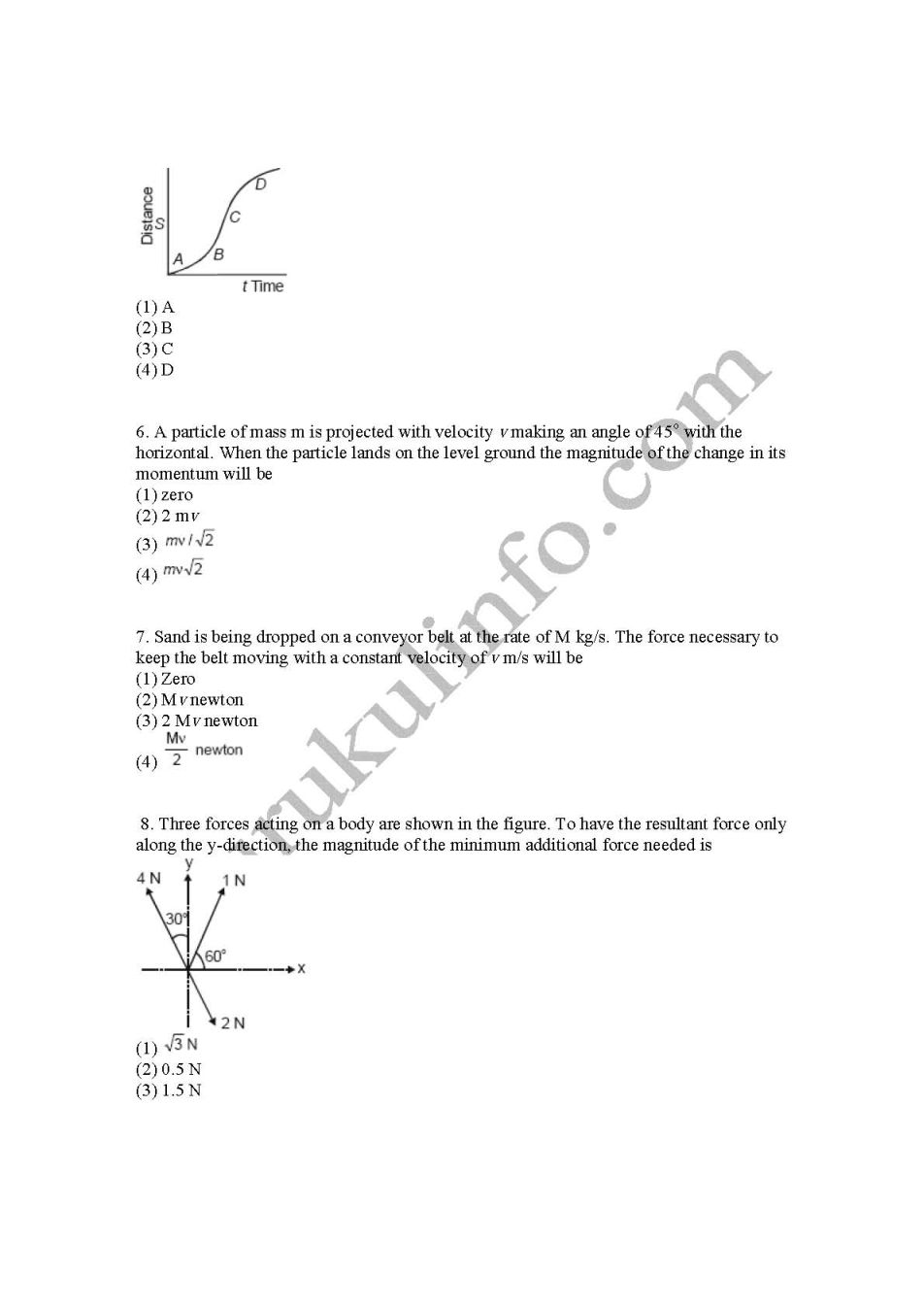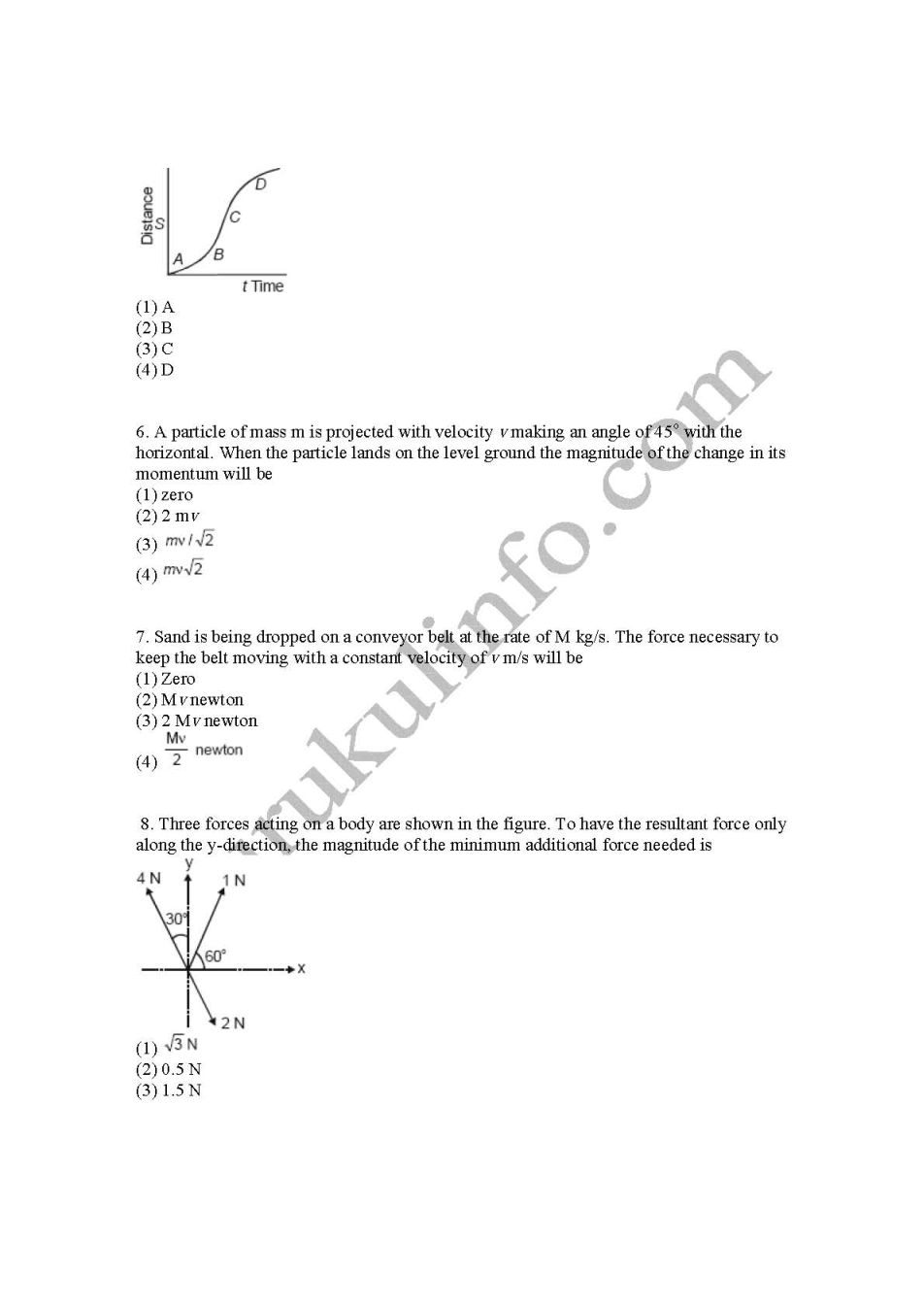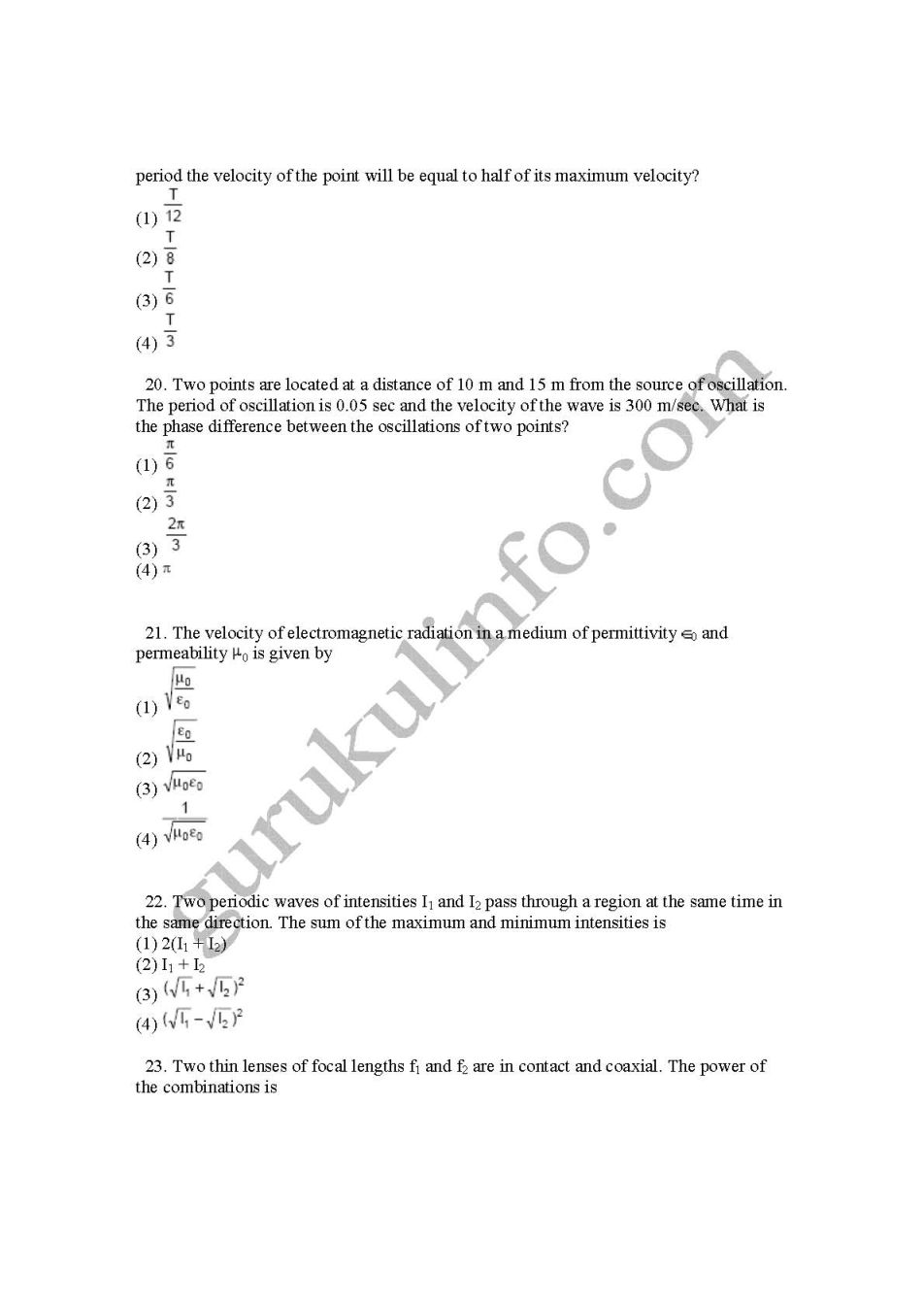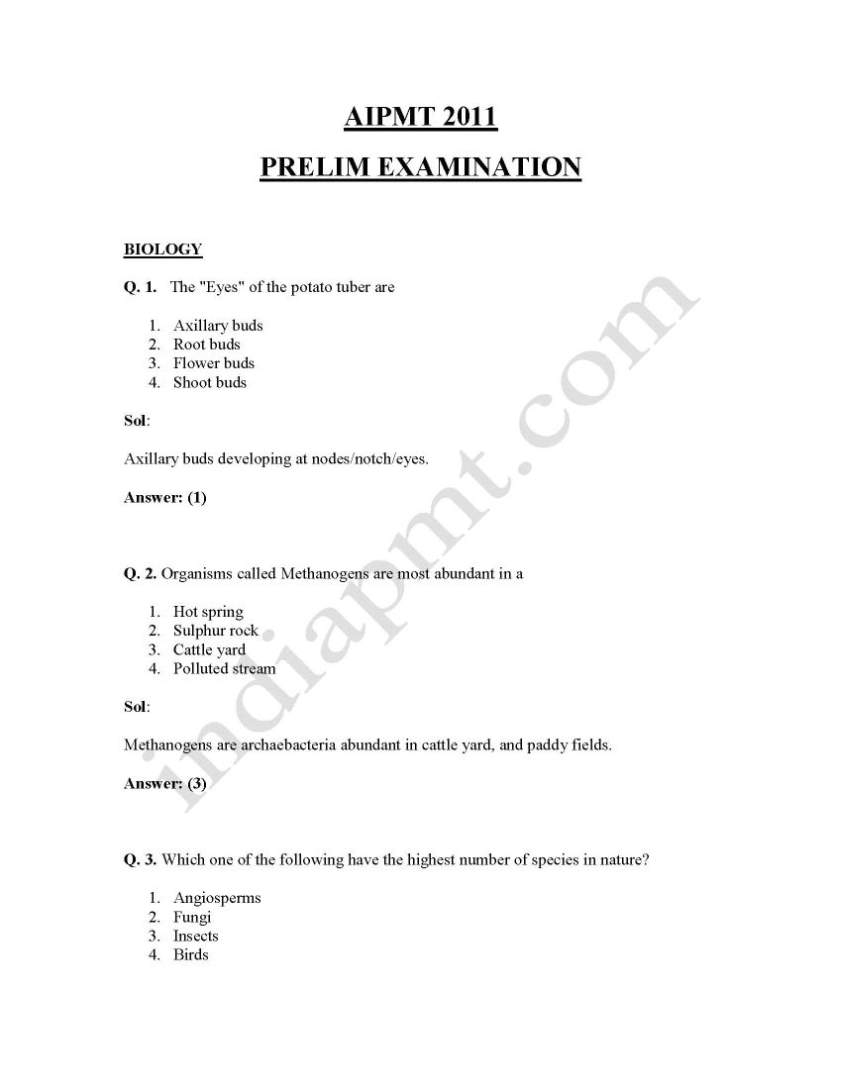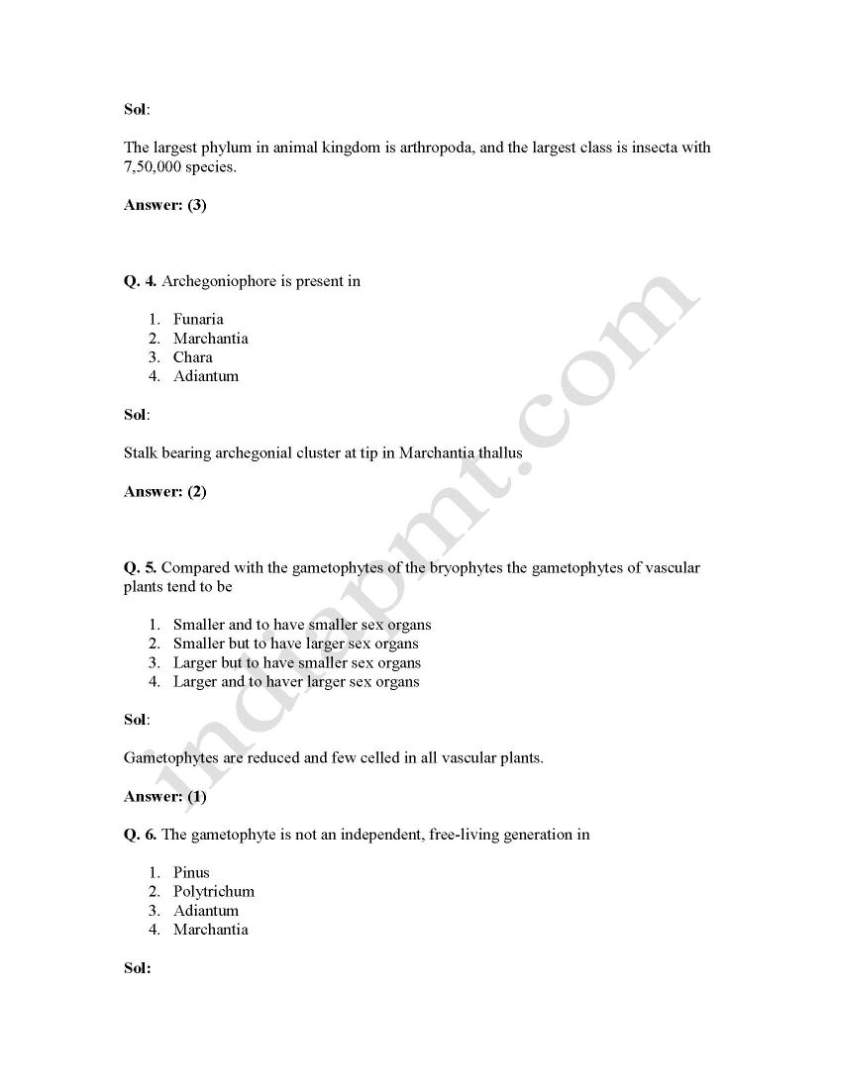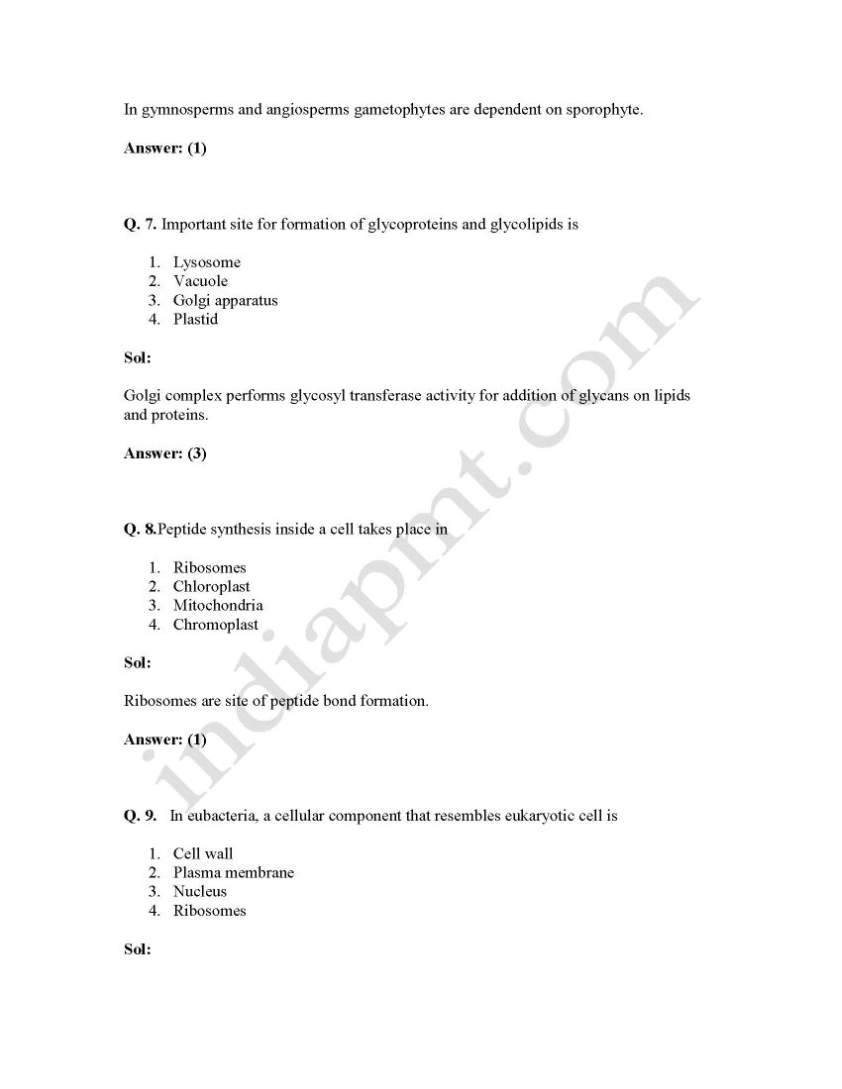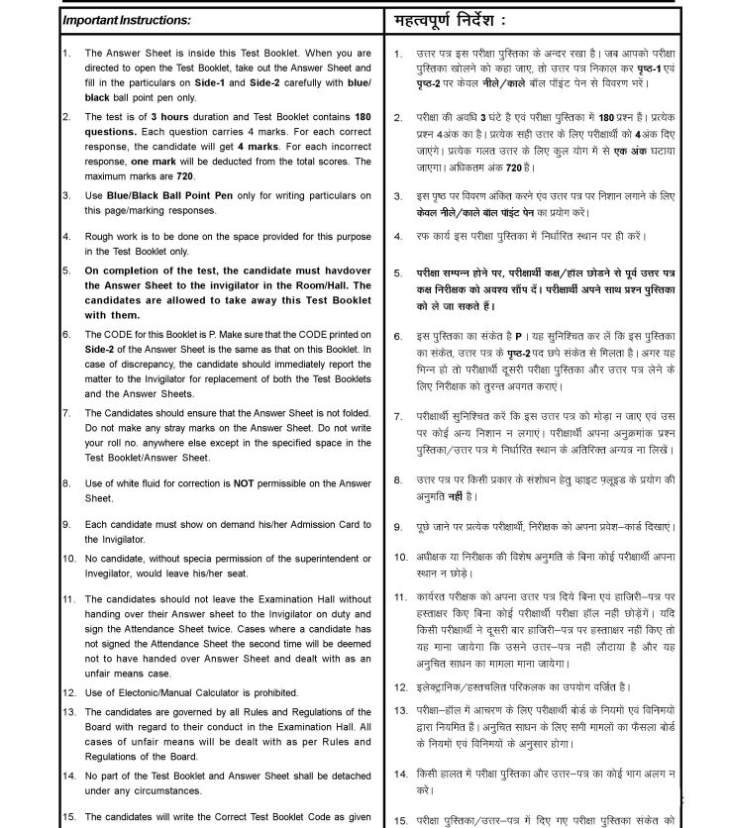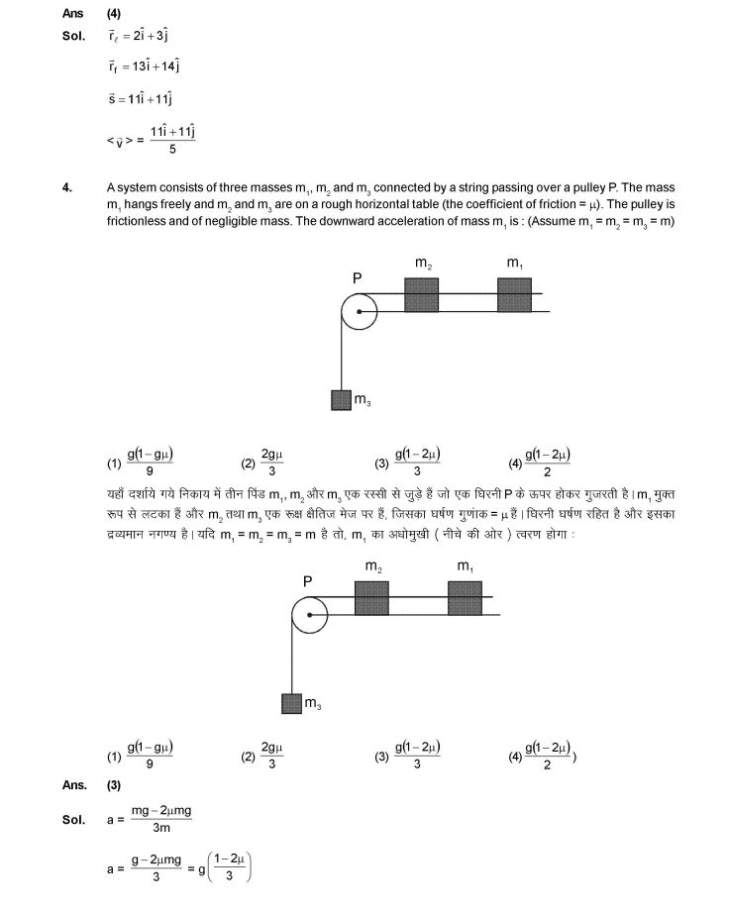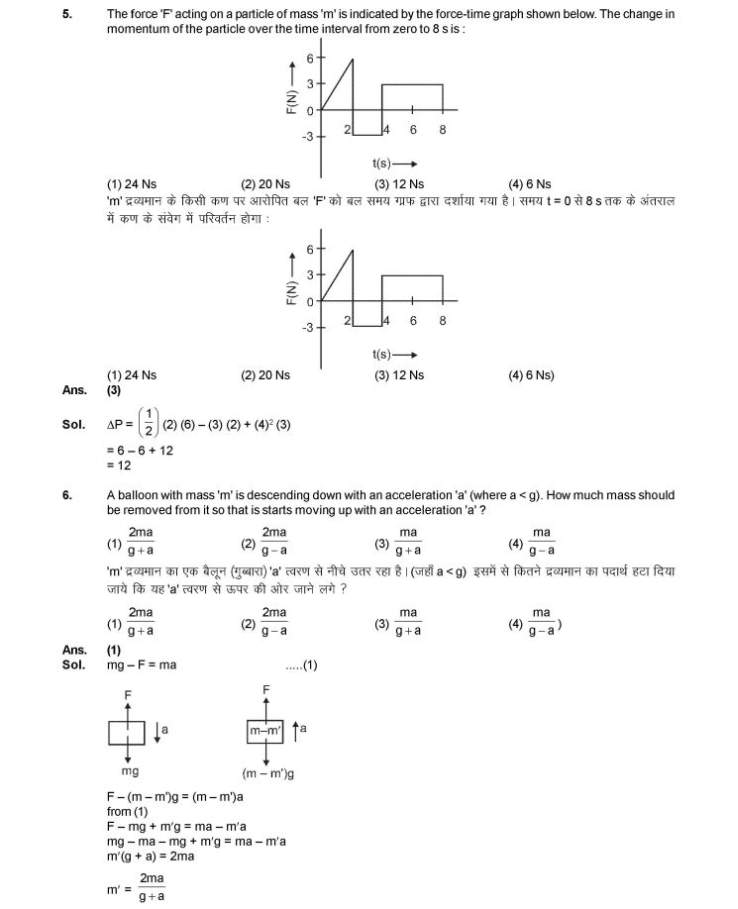As you are looking for the solved question paper of AIPMT exam , here i am providing list of few questions for your idea.
Q. 1. Biological organisation starts with:
a. Atomic level
b. Submicroscopic molecular level
c. Cellular level
d. Organismic level
Sol. Correct choice: (2)
Q. 2. About 98 percent of the mass of every living organism is composed of just six
elements including carbon, hydrogen, nitrogen, oxygen and:
a. calcium and phosphorous
b. phosphorus and sulphur
c. sulphur and magnesium
d. magnesium and sodium
Sol. Correct choice: (1)
Q. 3. Which one of the following is an example of negative feed back loop in humans?
a. Secretion of sweat glands and constriction of skin blood vessels when it is too hot.
b. Constriction of skin blood vessels and contraction of skeletal muscles when it is
too cold.
c. Secretion of tears after falling of sand particles in to the eye
d. Salivation of mouth at the sight of delicious food.
Sol. When the set point of hypothalamus is disturbed by high temperature, it stimulates
vasodilation and sweating while in low temperature there is vasoconstriction and
shivering. Correct choice: (2)
Q. 4. What is common to whale, seal and shark?
a. Homoiothermy
b. Seasonal migration]
c. Thick subcutaneous fat
d. Convergent evolution
Sol. Shark is poikilothermous. All three species show adaptations for aquatic life while
these are not closely related. Correct choice: (4)
Q. 5. Which one of the following is not a constituent of cell membrane?
a. Phospholipids
b. Cholesterol
c. Glycolipids
d. Proline
Sol. Correct choice: (4)
Q. 6. Select the wrong statement from the following:
a. The chloroplasts are generally much larger than mitochondria.
b. Both chloroplasts and mitochondria contain and inner and an outer membrane
c. Both chloroplasts and mitochondria have an internal compartment, the thylakoid
space bounded by the thylakoid membrane
d. Both chloroplasts and mitochondria contain DNA.
Sol. Correct choice: (3)
Q. 7. The overall goal of glycolysis, Krebs cycle and the electron transport system is the
formation of:
a. Nucleic acids
b. ATP is small stepwise units
c. ATP in one large oxidation reaction
d. Sugars
Sol. Correct choice: (2)
Q. 8. If the mean and the median pertaining to a certain character of a population are of
the same value, the following is most likely to occur:
a. a skewed curve
b. a normal distribution
c. a bi-modal distribution
d. a T -shaped curve
Sol. Correct choice: (2)
Q. 9. Which one of the following is a slime mould?
a. Anabaena
b. Rhizopus
c. Physarum
d. Thiobacillus
Sol. Physarum is an acellular slime mould. Correct choice: (3)
Q.10. For a critical study of secondary growth in plants, which one of the following pairs
is suitable?
a. Wheat and maiden hair fern
b. Sugarcane and sunflower
c. Teak and pine
d. Deodar and fern
Sol. Secondary growth occurs in gymnosperms and dicots. Correct choice: (3)
Q.11. Which one of the following statements about Mycoplasma is wrong?
a. They cause disease in plants
b. They are also called PPLO
c. They are pleomorphic
d. They are sensitive to penicillin
Sol. Mycoplasma is not sensitive to penicillin due to absence of cell wall. Correct choice:
(4)
Q.12. In the prothallus of vascular cryptogam, the antherozoids and eggs mature at
different times. As a result:
a. self fertilization is prevented
b. there is no change in success rate of fertilization
c. there is high degree of sterility
d. one can conclude that the plant is apomictic
Sol. In vascular cryptogam i.e. in pteridophytes gametophyte is monoecious but
protandrous to avoid self fertilization. Correct choice: (1)
Q.13. Two plants can be conclusively said to belong to the same species if they:
a. have same number of chromosomes
b. can reproduce freely with each other and form seeds
c. have more than 90 per cent similar genes
d. look similar and possess identical secondary metabolities.
Sol. The members of a species are inter-fertile and produce fertile offsprings. Correct
choice: (2)
Q.14. If you are asked to classify the various algae into distinct groups, which of the
following characters you should choose?
a. Chemical composition of the cell wall
b. Types of pigments present in the cell
c. Nature of stored food materials in the cell
d. Structural organization of thallus.
Sol. The various algae are classified mainly on the types of pigments present in their
cells. Correct choice: (2)
Q.15. Flagellated male gametes are present in all the three of which one of the following
sets?
a. Riccia, Dryopteris and Cycas
b. Anthoceros, Funaria and Spirogyra
c. Zygnema, Saprolegnia and Hydrilla
d. Fucus, Marsilea and Calotropis
Sol. The male gametes of bryophytes are biflagellete, and those of pteriodophytes are
multiflagellate, except Selaginella having biflagellate gametes. The male gametes of
gymnosperms are non motile except those of Cycas having multiciliate gametes. Correct
choice: (1)
Q.16. In gymnosperms, the pollen chamber represents:
a. the microsporangium in which pollen grains develop
b. a cell in the pollen grain in which the sperms formed
c. a cavity in the ovule in which pollen grains are stored after pollination
d. an opening in the mega gametophyte through which the pollen tube approaches
the egg.
Sol. In gymnosperms, below micropylar beak some of the cells of nucellus of ovule
disintigerate to form pollen chamber. Correct choice: (3)
Q.17. Spore dissemination in some liverworts is aided by:
a. peristome teeth
b. elaters
c. indusium
d. calyptra
Sol. In some liverworts like Marchantia spore dispersal is due to hydrochasy and is aided
by elaters. Correct choice: (2)
Q.18. Which pair of the following belongs to Basidiomycetes?
a. Morchella and Mushrooms
b. Birds’ nest fungi and Pufballs
c. Pufballs and Claviceps
d. Peziza and Stink horns
Sol. Bird’s nest fungi – Cyathus, Pufballs – Lycoperdon, Both belong to the class
Basidiomycetes. Correct choice: (3)
Q.19. ICBN stands for:
a. Indian Code of Botanical Nomenclature
b. Indian Congress of Biological Names
c. International Code of Botanical Nomenclature
d. International Congress of Biological Names
Sol. ICBN is one of the codes of nomenclature. It stands for International Code of
Botanical Nomenclature. Correct choice: (3)
Q. 20. Ergot of rye is caused by a species of:
a. Claviceps
b. Phytophthora
c. Uncinula
d. Ustilago
Sol. Ergot of rye is caused by Claviceps purpurea. Correct choice: (1)
Q. 21. When two species of different genealogy come to resemble each other as a result
of adaptation, the phenomenon is termed:
a. Convergent evolution
b. Divergent evolution
c. Microevolution
d. Co-evolution
Sol. Correct choice: (1)
Q. 22. Adaptive radiation refers to:
a. Power of adaptation in an individual to a variety of environments
b. Adaptations due to Geographical isolation
c. Evolution of different species from a common ancestor
d. Migration of members of a species to different geographical areas
Sol. Correct choice: (3)
Q. 23. The living organisms can be unexceptionally distinguished from the non-living
things on the basis of their ability for:
a. growth the movement
b. responsiveness to touch
c. interaction with the environment and progressive evolution
d. reproduction
Sol. Correct choice: (4)
Q. 24. The Finches of Galapogas islands provide an evidence in favour of:
a. Biogeographical Evolution
b. Special Creation
c. Evolution due to Mutation
d. Retrogressive Evolution
Sol. Correct choice: (1)
Q. 25. One of the important consequences of geographical isolation is:
a. Random creation of new species
b. No change in the isolation faunax
c. Preventing Speciation
d. Speciation through reproductive isolation
Sol. Correct choice: (4)
Q. 26. Industrial melanism as observed in peppered moth proves that:
a. Melanism is a pollution-generated feature
b. The true black melanic forms arise by a recurring random mutation
c. The melanic form of the moth has no selective advantage over lighter form in
industrial area
d. The lighter-form moth has no selective advantage either in polluted industrial area
or non-polluted area.
Sol. It is an example of directional selection. Correct choice: (2)
Q. 27. The concept of chemical evolution is based on:
a. Possible origin of life by combination of chemicals
b. Crystallization of chemicals under suitable environmental conditions
c. Interaction of water, air and clay under
d. Effect of solar radiation of chemicals
Sol. Correct choice: (1)
Q. 28. Among the human ancestors the brain size was more than 1000 CC in:
a. Homo habilis
b. Homo neanderthalensis
c. Homo erectus
d. Ramapithecus
Sol. Homo habilis had a cranial capacity in the range of 680-720 c.c. & that of
Homo erectus erectus 775-990 c.c,
Homo erectus pekinensis 915-1200 c.c.
Homo neanderthalensis 1300-1600 c.c. Correct choice:
Q. 29. Which of the following pairs are correctly matched?
a. Crocodile
b. Sea Urchin
c. Obelia
d. Lemur
- 4-Chambered heart
- Parapodia
– Metagenesis
– Thecodont
(1) Only A and B
(2) A, C and D
(3) B, C and D
(4) Only A and D
Sol. Correct choice: (2)
Q. 30. Select the correct statement from the following:
a. Mutations are random and directional
b. Darwinian variations are small and directionless
c. Fitness is the end result of the ability to adapt and gets selected by nature
d. All mammals except whales and camels have seven cervical vertebrate.
Sol. It explains natural selection. Correct choice: (3)
Q. 31. Which one of the following is a matching pair of a body feature and the animal
possessing it?
a. Ventral heart
b. Post-anal tail
c. Ventral Central nervous
system
d. Pharyngeal gill slits absent in
embryo
- Scorpion
- Octopus
– Leech
– Chamaeleon
Sol. Scorpion has dorsal heart. Post-anal tail is found only in chordates. Pharyngeal gill
slits are present in the embryo of chameleon. Correct choice: (3)
Q. 32. What is common between parrot, platypus and kangaroo?
a. Ovoparity
b. Homoiothermy
c. Toothless jaws
d. Functional post -anal tail
Sol. Only birds & mammals are homoiothermous. Correct choice: (2)
Q. 33. What is true about Nereis, Scorpion, Cockroach and Silver fish?
a. They all belong to the same phylum
b. They all have jointed paired appendages
c. They all possess dorsal heart
d. None of them is aquatic
Sol. Correct choice: (3)
Q. 34. Which one of the following statement is correct?
a. Ontogeny repeats phylogeny
b. Stem cells are specialized cells
c. There is no evidence of the existence of gills during embryogenesis of mammals
d. All plant and animal cells are totipotent.
Sol. Correct choice: (1)
Q. 35. “Foolish Seedling” disease of rice led to the discovery of:
a. IAA
b. GA
c. ABA
d. 2, 4 – D
Sol. Foolish seeding disease (Bakane disease) of rice is due to a fungus Giberella
fujikuroi. Yabuta and Sumuki obtained achemical from the fungus and called gibbrellic
acid. Correct choice: (2)
Q. 36. Passage cells are thin- walled cells found in:
a. central region of style through which the pollen tube grows towards the ovary.
b. endodermis of roots facilitating rapid transport of water from cortex to pericycle.
c. phloem elements that serve as entry points for substances for transport to other
plant parts.
d. testa of seed to enable emergence of growing embryonic axis during seed
germination.
Sol. Passage cells also called transfusion tissue are found in the endodermis meant for
rapid transport of water from cortex to pericycle. Correct choice: (2)
Q. 37. The first acceptor of electrons from an excited chlorophyll molecule of
photosystem II is:
a. Quinone
b. Cytochrome
c. Iron-sulphur protein
d. Ferredoxin.
Sol. The first acceptor of electros from an excited chlorophyll is quinone. Correct choice:
(1)
Q. 38. All enzymes of TCA cycle are located in the mitochondrial matrix except one
which is located in inner mitochondrial membranes in eukaryotes and in cytosol in
prokaryotes. This enzyme is:
a. succinate dehydrogenase
b. lactate dehydrogenase
c. isocitrate dehydrogenase
d. malate dehydrogenase
Sol. Succinate dehydrogenase is a common enzyme for TCA and ETC. It is located on
inner mitochondrial membrane. Rest of the TCA enzymes are present in mitochondrial
matrix. Correct choice: (1)
Q. 39. The wavelength of light absorbed by
Pr form of phytochrome is:
a. 620 nm
b. 640 nm
c. 680 nm
d. 720 nm
Sol. The
Pr form of phytochrome receives red light (600-680 nm) and changes into Pfr.
Correct choice: (3)
Q. 40. Opening of floral buds into flowers, is type of:
a. Autonomic movement of growth
b. Autonomic movement of locomotion
c. Autonomic movement of variation
d. Paratonic movement of growth.
Sol. Opening of floral bud into flowers, is due to epinasty, a type of autonomic movement
of growth. Correct choice: (1)
Q. 41. Which one of the following pairs, is not correctly matched?
a. IAA - Cell wall elongation
b. Abscissic Acid - Stomatal closure
c. Gibberellic Acid - Leaf fall
d. Cytokinin - Cell division
Sol. Leaf fall is due to interaction of auxin and ethylene. Correct choice: (3)
Q. 42. One gene - one enzyme relationship was established for the first time in:
a. Diploccus pneumoniae
b. Neurospora crassa
c. Salmonella typhimurium
d. Escherichia Coli
Sol. One gene-one enzyme hypothesis was given by Beadle and Tatum in red mould
(Neurospora crassa). Correct choice: (2)
Q. 43. Male gametes in angiosperms are formed by the division of:
a. Microspore mother cell
b. Microspore
c. Generative cell
d. Vegetative cell
Sol. During the development of male gametophyte first of all two cells – generative cell
and tube nucleus are formed from a pollen. This twocelled stage is called pollen grain.
Finally the generative cell divides to form 2-male gametes. Correct choice: (3)
Q. 44. Two cells A and B are contiguous. Cell A has osmotic pressure 10 atm, turgor
pressure - 7atm and diffusion pressure deficit 3 atm. Cell B has osmotic pressure 8 atm,
turgor pressure 3 atm and diffusion pressure deficit 5 atm. The result will be:
a. Movement of water of Cell A to B
b. Movement of water from Cell B to A
c. No movement of water
d. Equilibrium between the two
Sol. The direction of movement of water is from low to high DPD. Correct choice: (1)
Q. 45. In the leaves of C4 plants, malic acid formation during CO2 fixation occurs in the
cells of:
a. Epidermis
b. Mesophyll
c. Bundle Sheath
d. Phloem
Sol. In C4 plants, C4 cycle occurs in mesophyll cells and C3 cycle in bundle sheath cells.
Correct choice: (2)
Q. 46. Which of the following is a flowering plant with nodules containing filamentous
nitrogen-fixing microorganism?
a. Cicer arietinum
b. Casuarina equisetifolia
c. Crotalaria juncea
d. Cycas revolute
Sol. The filamentous nitrogen – fixing microorganism like Frankia occurs in root-nodules
of non-leguminous plants like Casuarina and Alnus. Correct choice: (2)
Q. 47. Which one of the following is surrounded by a callose wall?
a. Pollen grain
b. Microspore mother cell
c. Male gamete
d. Egg
Sol. The microspore mother cells develops an internal layer of callose which breaks the
plasmodesmatal connections among themselves. Correct choice: (2)
Q. 48. Which one of the following elements is not an essential micronutrient for plant
growth?
a. Ca
b. Mn
c. Zn
d. Cu
Sol. Calcium is an essential macronutrient for plant growth. Correct choice: (1)
Q. 49. If you suspect major deficiency of antibodies in person, to which of the following
would you look for confirmatory evidence?
a. Haemocytes
b. Serum albumins
c. Serum globulins
d. Fibrinogen in the plasma
Sol. Correct choice: (3)
Q. 50. Which one of the following is a fat -soluble vitamin and its related deficiency
disease?
a. Calciferol – Pellagra
b. Ascorbic acid – Scurvy
c. Retinol – Xerophthalmia
d. Cobalamine – Beri-beri
Sol. Correct choice: (3)
Q. 51. Which one of the following mammalian cells is not capable of metabolising
glucose to carbon-dioxide aerobically?
a. Red blood cells
b. White blood cells
c. Unstriated muscle cells
d. Liver cells
Sol. RBCs do not have mitochondria & thus can respire only anaerobically. Correct
choice: (1)
Q. 52. Compared to a bull a bullock is docile because of:
a. lower levels of adrenalin / noradrenalin in its blood
b. higher levels of thyroxin
c. higher levels of cortisone
d. lower levels of blood testosterone
Sol. The bullock is castrated and therefore secretion of testosterone is not adequate.
Correct choice: (4)
Q. 53. In the human female, menstruation can be deferred by the administration of:
a. FSH only
b. LH only
c. Combination of FSH and LH
d. Combination of estrogen and progesterone
Sol. Correct choice: (4)
Q. 54. In human body, which one of the following is anatomically correct?
a. Cranial nerves
b. Floating ribs
c. Collar bones
d. Salivary glands
- 10 pairs
- 2 pairs
– 3 pairs
–1 pair
Sol. Correct choice: (2)
Q. 55. In which one of the following preparations are you likely to come across cell
junctions most frequently?
a. Hyaline cartilage
b. Ciliated epithelium
c. Thrombocytes
d. Tendon
Sol. Correct choice: (2)
Q. 56. A drop of each of the following, is placed separately on four slides. Which of them
will not coagulate?
a. Whole blood from pulmonary vein
b. Blood plasma
c. Blood serum
d. Sample from the thoracic duct of lymphatic system
Sol. Blood serum does not contain fibrinogen and few other clotting factors, thus it will
not coagulate. Correct choice: (3)
Q. 57. Feeling the tremors of an earthquake a scared resident of seventh floor of a
multistoryed building starts climbing down the stairs rapidly. Which hormone initiated
this action?
a. Gastrin
b. Thyroxin
c. Adrenaline
d. Glucagon
Sol. Correct choice: (3)
Q. 58. A person who is on a long hunger strike and is surviving only on water, will have:
a. less urea in his urine
b. more sodium in his urine
c. less amino acids in his urine
d. more glucose in his blood.
Sol. Correct choice: (1)
Q. 59. Which one of the following pairs of structures distinguishes a nerve cell from
other types of cell?
a. Nucleus and mitochondria
b. Perikaryon and dendrites
c. Vacuoles and fibers
d. Flagellum and medullary sheath
Sol. Correct choice: (2)
Q.60. Which part of ovary in mam mals acts as an endocrine gland after evolution?
a. Vitelline membrane
b. Graafian follicle
c. Stroma
d. Germinal epithelium
Sol. Correct choice: (2)
Q. 61. During the transmission of nerve impulse through a nerve fibre, the potential on
the inner side of the plasma membrane has which type of electric charge?
a. First positive, then negative and again back to positive
b. First negative, then positive and again back to negative
c. First positive, then negative and continue to be negative
d. First negative, then positive and continue to be positive.
Sol. Correct choice: (2)
Q. 62. A person is having problems with calcium and phosphorous metabolism in his
body. Which one of the following glands may not be functioning properly?
a. Thyroid
b. Parathyroid
c. Parotid
d. Pancreas
Sol. Correct choice: (2)
Q. 63. Identify the odd combination of the habitat and the particular animal concerned:
a. Rann of Kutch
b. Dachigam National Park
c. Sunderbans
d. Periyar
- Wild Ass
- Snow Leopard
–Bengal Tiger
–Elephant
Sol. Dachigam National Park is for the conservation of Hangul.
Correct choice: (2)
Q. 64. In which one of the following the BOD (Biochemical Oxygen Demand) of sewage
(S), distillery effluent (DE), paper mill effluent (PE) and sugar mill effluent (SE) have
been arranged in ascending order?
a. S < DE < PE < SE
b. SE < S < PE < DE
c. SE < PE < S < DE
d. PE < S < SE < DE
Sol. BOD of distillery effluent is 40,000 mg / l and that of paper mill effluent and sewage
is 190 mg/l and 30 mg/l, respectively. Correct choice: (2)
Q. 65. Which one of the following ecosystem types has the highest annual net primary
productivity?
a. Temperate deciduous forest
b. Tropical rain forest
c. Tropical deciduous forest
d. Temperate evergreen forest
Sol. Tropical rain forest has highest annual net primary productivity (9000 K cal / m 2 /
yr). Correct choice: (2)
Q. 66. Which one of the following is being utilized as a source of biodiesel in the Indian
countryside?
a. Pongamia
b. Euphorbia
c. Beetroot
d. Sugarcane
Sol. Pongamia, Jatropa, Euphorbia are petrocrops. However, in the Indian countryside,
Pongamia (Kanjar) is being utilized as a source of biodiesel. Correct choice: (1)
Q. 67. In a coal fires power plant electrostatic precipitators are installed to control
emission of:
a. CO
b. SO2
c. NOX
d. SPM
Sol. Electrostatic precipitators control emission of suspended particle matter (SPM).
Correct choice: (4)
Q. 68. Which one of the following is not a bioindicator of water pollution?
a. Sewage fungus
b. Sludge-worms
c. Blood-worms
d. Stone flies
Sol. Correct choice: (4)
Q. 69. A high density of elephant population in an area can result in:
a. Predation on one another
b. Mutualism
c. Intra specific competition
d. Inter specific competition
Sol. Intra-specific competition occurs between the members of the same species. Correct
choice: (3)
Q. 70. Geometric representation of age structure is a characteristic of:
a. Ecosystem
b. Biotic community
c. Population
d. Landscape
Sol. Age structure is one of the characteristics of population. Correct choice: (3)
Q. 71. Which one of the following pairs of organisms are exotic species introduced in
India?
a. Nile perch, Ficus religiosa
b. Ficus religiosa, Lantana camara
c. Lantana camara, Water hyacinth
d. Water hyacinth, Prosopis cineraria
Sol. Lantana camara and Eicchornia czassipes (water hyacinth) are exotic species.
Correct choice: (3)
Q. 72. One of endangered species of Indian medicinal plants is that of:
a. Nepenthes
b. Podophyllum
c. Ocimum
d. Garlic
Sol. Podophyllum hexandrum - : (Papri), gives a drug from its rhizome; besides being
stimulant and purgative and has destructive action on cancerous tissues. Correct choice:
(2)
Q. 73. A genetically engineered micro-organism used successfully in bioremediation of
oil spills is a species of:
a. Bacillus
b. Pseudomonas
c. Trichoderma
d. Xanthomonas
Sol. Pseudomonas putida (superbug) developed by genetic engineering by Anand Mohan
Chakravorty is used to control oil spills. Correct choice: (2)
Q. 74. A sequential expression of a set of human genes occurs when a steroid molecule
binds to the:
a. Ribosome
b. Transfer RNA
c. Messenger RNA
d. DNA sequence
Sol. Correct choice: (4)
Q. 75. The Okazaki fragments in DNA chain growth:
a. polymerize in the direction and explain DNA replication
b. result in transcription
c. polymerize in the direction and forms replication fork
d. prove semi-conservative nature of DNA replication
Sol. Replication occurs always in direction. Okazaki fragments, synthesized on
DNA template, join to form lagging strand which grows in direction. Correct
choice: (1)
Q. 76. In the hexaploid wheat, the haploid (n) and basic (x) numbers of chromosomes
are:
a. n = 21 and x = 7
b. n = 7 and x = 21
c. n = 21 and x = 21
d. n = 21 and x = 14
Sol. The basic number (x) of wheat is 7. Thus the 6x = 2n = 42 and n = 21. Correct
choice: (1)
Q. 77. Molecular basis of organ differentiation depends on the modulation in
transcription by:
a. Anticodon
b. RNA polymerase
c. Ribosome
d. Transcription factor
Sol. Correct choice: (4)
Q. 78. Telomere repetitive DNA sequence control the function of eukaryote
chromosomes because they:
a. prevent chromosome loss
b. act as replicons
c. are RNA transcription initiator
d. help chromosome pairing
Sol. Telomerase seal the ends of the chromosomes. Correct choice: (1)
Q. 79. Inheritance of skin colour in humans is an example of:
a. codominance
b. chromosomal aberration
c. point mutation
d. polygenic inheritance
Sol. Inheritance of skin colour in human is controlled by three genes, A, B and C. Correct
choice: (4)
Q. 80. A common test to find the genotype of a hybrid is by:
a. crossing of one F1progeny with male parent
b. crossing of one F2 progeny with male parent
c. crossing of one F2 progeny with female parent
d. studying the sexual behaviour of F1 progenies.
Sol. To find the genotype of hybrid, it is test crossed. Correct choice: (1)
For more questions , here i am giving attachment

